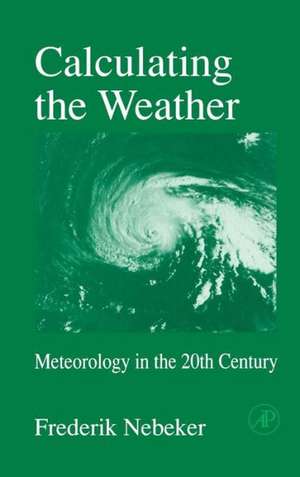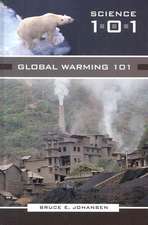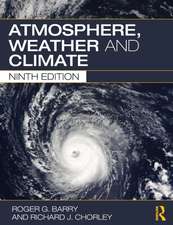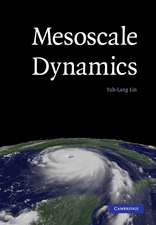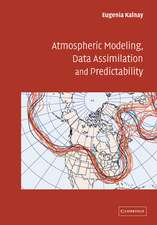Calculating the Weather: Meteorology in the 20th Century: International Geophysics, cartea 60
Autor Frederik Nebekeren Limba Engleză Hardback – 17 mai 1995
Key Features* Provides a narrative account of the growth of meteorology in the 20th century* Explains how forecasting the weather became a physics-based science* Studies the impact of the computer on meteorology and thus provides an example of science transformed by the computer* Describes three traditions in meteorology:* The empirical tradition of gathering data and making inferences* A theoretical tradition of explaining atmospheric motions by means of the laws of physics* The practical tradition of predicting the weather* Analyzes the increasing role of calculation within each of the traditions and explains how electronic digital computers made possible many connections between traditions
Din seria International Geophysics
- 4%
 Preț: 369.81 lei
Preț: 369.81 lei - 27%
 Preț: 443.84 lei
Preț: 443.84 lei - 23%
 Preț: 519.23 lei
Preț: 519.23 lei - 26%
 Preț: 652.08 lei
Preț: 652.08 lei - 23%
 Preț: 585.62 lei
Preț: 585.62 lei - 23%
 Preț: 436.59 lei
Preț: 436.59 lei - 23%
 Preț: 439.43 lei
Preț: 439.43 lei - 23%
 Preț: 438.68 lei
Preț: 438.68 lei - 8%
 Preț: 325.26 lei
Preț: 325.26 lei - 8%
 Preț: 395.78 lei
Preț: 395.78 lei - 27%
 Preț: 694.98 lei
Preț: 694.98 lei - 27%
 Preț: 686.70 lei
Preț: 686.70 lei - 23%
 Preț: 440.31 lei
Preț: 440.31 lei - 28%
 Preț: 348.45 lei
Preț: 348.45 lei - 27%
 Preț: 712.55 lei
Preț: 712.55 lei -
 Preț: 402.34 lei
Preț: 402.34 lei - 27%
 Preț: 1236.31 lei
Preț: 1236.31 lei - 23%
 Preț: 532.18 lei
Preț: 532.18 lei - 27%
 Preț: 902.35 lei
Preț: 902.35 lei - 23%
 Preț: 549.93 lei
Preț: 549.93 lei - 30%
 Preț: 454.27 lei
Preț: 454.27 lei - 27%
 Preț: 773.45 lei
Preț: 773.45 lei - 26%
 Preț: 409.38 lei
Preț: 409.38 lei
Preț: 436.30 lei
Preț vechi: 566.61 lei
-23% Nou
Puncte Express: 654
Preț estimativ în valută:
83.49€ • 87.39$ • 69.49£
83.49€ • 87.39$ • 69.49£
Carte tipărită la comandă
Livrare economică 31 martie-14 aprilie
Preluare comenzi: 021 569.72.76
Specificații
ISBN-13: 9780125151757
ISBN-10: 0125151756
Pagini: 255
Dimensiuni: 152 x 229 x 19 mm
Greutate: 0.54 kg
Editura: ELSEVIER SCIENCE
Seria International Geophysics
ISBN-10: 0125151756
Pagini: 255
Dimensiuni: 152 x 229 x 19 mm
Greutate: 0.54 kg
Editura: ELSEVIER SCIENCE
Seria International Geophysics
Public țintă
AUDIENCE: Meteorologists, atmospheric scientists, historians of science, earth scientists, and mathematicians working in the areas of computational math and math history.Cuprins
Introduction. Part I. Meteorology in 1900. An Empirical Tradition: Climatology. A Theoretical Tradition: Physics of the Atmosphere. A Practical Tradition: Weather Forecasting. Part II. Meteorology in the First Half ofthe 20th Century. Vilhelm Bjerkness Program to Unify Meteorology. Lewis Fry Richardson: The First Person to Compute the Weather. The Growth of Meteorology. Meteorological Calculation in the Interwar Period. The Effect of World War II on Meteorology. Part III. The Beginning of the Computer Era in Meteorology. John von Neumanns Meteorology Project. The Acceptance of Numerical Meteorology. The Unification of Meteorology. The Recognition of Limits to Weather Prediction. Endnotes. Notes on Sources. References. Index.
Recenzii
"The book is well written and pleasant to read and includes about 450 references and a good index... Readers interested in the early history of numerical forecasting will find it a useful summary." --NATURE
"There is an extensive set of notes that accompanies the chapters, references, and an extremely 'friendly index that unerringly points the reader to the correct page by subject and/or person. I was unable to find any typographical errors. I also compared quotations in the text with source material and found the author to be absolutely accurate in working and location. This accuracy and attention to detail breeds confidence in the material presented.Tracking quantitative meterology over the 100-year span (1850-1950) is admirably accomplished by Nebeker.I was especially pleased with his discussion of the early work in predictability that generously quotes from the research papers of George Platzman and Philip Thompson....Via the avenue of stimulation and through an abundance of historically accurate accounts, Nebeker has added an important contribution to the recent history of meterology." --BULLETIN OF AMERICAN METEOROLOGICAL SOCIETY
"This book surveys the progress of numerical methods in meteorology over the course of the 20th century. The author takes care to explain most tehcnical concepts...the book reads well and offers convincing suggestions of the ways in which institutional and military factors directed meteorology toward computional approaches. CALCULATING THE WEATHER is a welcome addition to a field still largely neglected by historians of science." --Theodore S. Feldman, TECHNOLOGY AND CULTURE.
"There is an extensive set of notes that accompanies the chapters, references, and an extremely 'friendly index that unerringly points the reader to the correct page by subject and/or person. I was unable to find any typographical errors. I also compared quotations in the text with source material and found the author to be absolutely accurate in working and location. This accuracy and attention to detail breeds confidence in the material presented.Tracking quantitative meterology over the 100-year span (1850-1950) is admirably accomplished by Nebeker.I was especially pleased with his discussion of the early work in predictability that generously quotes from the research papers of George Platzman and Philip Thompson....Via the avenue of stimulation and through an abundance of historically accurate accounts, Nebeker has added an important contribution to the recent history of meterology." --BULLETIN OF AMERICAN METEOROLOGICAL SOCIETY
"This book surveys the progress of numerical methods in meteorology over the course of the 20th century. The author takes care to explain most tehcnical concepts...the book reads well and offers convincing suggestions of the ways in which institutional and military factors directed meteorology toward computional approaches. CALCULATING THE WEATHER is a welcome addition to a field still largely neglected by historians of science." --Theodore S. Feldman, TECHNOLOGY AND CULTURE.
